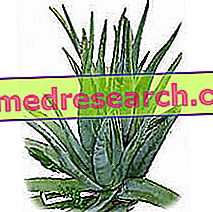
Scientific name
Aloe vera L., left Aloe Barbadensis Miller (Aloe from Barbados)
Aloe ferox Miller (Cape Aloe)
Family
AsphodelaceaeOrigin
Aloe is a plant native to Central America, Africa and the Mediterranean regions.Used Parts
From any Aloe plant it is possible to obtain two types of extracts ( condensed juice and gel ), with very different chemical and physical characteristics.
Aloe condensed juice
Aloe juice is obtained by percolation from the leaves, which are previously incised. The liquid thus collected is dried to obtain a mass that - once cooled - takes on a glassy consistency.
Chemical constituents
- Anthraquinone glucosides (among which we recall aloin - also called barbaloin - and aloe-emodin), it is to these compounds that we owe the drastic purgative effect that characterizes the aloe juice.
- Flavonoids .
Properties of Aloe juice
The main properties of aloe juice are laxative ones. The constituents become part of many drugs, but like all anthraquinones they must be used only in special cases.
Aloe is also a component of liqueurs called "fernet".
Biological activity
As mentioned, the aloe juice is used for its powerful laxative action; therapeutic application, among other things, for which the use of aloe juice has been officially approved. However, due to the decidedly drastic purgative action, the use of aloe juice as a laxative should be limited only to particular cases and conditions.
The substances present in the aloe extract act by inducing an active secretion of water and electrolytes in the intestinal lumen, preventing their reabsorption in the colon.
In addition, the antibacterial and antiviral properties are also attributed to the aloe-emodin contained in the aloe juice. In fact, studies have shown that this anthraquinone derivative is able to inhibit the growth of Helicobacter pylori and of some methicillin-resistant Staphylococcus aureus (or MRSA) strains.
Aloe-emodin has then shown virucidal activity against Herpes simplex type 1 and 2 viruses, varicella-zoster virus, pseudorabies virus (or Aujeszky's disease) and influenza virus.
Furthermore, several studies have also been carried out on aloe-emodin in order to investigate the presumed antitumor properties.
Aloe juice to counteract occasional constipation
As stated, aloe juice can be used to treat occasional constipation, thanks to the activity performed by the anthraquinone glycosides it contains.
As an indication, it is advisable to take an amount of aloe juice corresponding to 10-30 mg of anthraquinone derivatives calculated as anhydrous aloin.
For further information regarding the use of aloe juice to overcome constipation, see the article on "Treating yourself with Aloe juice".
Side effects
The intake of aloe juice can cause gastrointestinal side effects, such as cramps and spasms. Furthermore, prolonged use can cause pigmentation of the intestinal mucosa and can lead to albuminuria, hematuria and excessive loss of electrolytes.
Contraindications
Do not take aloe juice in case of hypersensitivity to one or more components and in case of intestinal obstruction, colitis, gastritis, Crohn's disease, appendicitis, diverticulitis or abdominal pain of unidentified origin.
The intake of aloe is not recommended even in pregnancy, during lactation and in children under 12 years of age.
Pharmacological Interactions
Excessive and prolonged use of anthraquinone laxatives such as aloe juice can lead to numerous interactions with drugs or other medicinal plants. Among these, we recall:
- Cardiotonic (Digital, Adonide, Mughetto, Scilla, Strofanto etc.), since aloe can increase its toxicity.
- Licorice, diuretic and corticosteroids, since excessive loss of potassium can occur in case of concomitant administration with aloe.
- Antiarrhythmics (quinidine, hydroquinidine), because the intake of aloe can cause an increase in toxicity with a risk of torsade de pointes (from hypokalemia).
- Analgesics .
- Halofantrine, as there is an increased risk of ventricular arrhythmia, in particular, due to torsades de pointes.
- Beta-blockers, because, even in this case, there is the risk of onset of torsion.
- Macrolides and vincamine, as it increases the risk of ventricular arrhythmias.
Aloe gel
For the production of the gel the gelatinous central part of the leaf is used (central parenchymatous part), from which a product is obtained without - or in any case with very low quantities - of anthracene principles.
More precisely, the gel is obtained by compression or extraction from the leaves and is commercially available as a raw gel.
Chemical constituents
- Water ;
- Polysaccharides ;
- Lecithins ;
- Amino acids ;
- Saponins ;
- Steroids ;
- Vitamins ;
- Enzymes ;
- Organic acids
- Mucilages .
Aloe gel properties
Aloe gel is used as an anti-inflammatory and immunostimulant. Among the most important properties, for external use the gel is used to treat burns, burns, erythema, wounds and scars.
Biological activity
As mentioned, aloe gel is given anti-inflammatory, immunostimulating and even healing properties.
The components of the aloe gel responsible for the anti-inflammatory action have not yet been fully identified, but they seem to exert their anti-inflammatory action by interfering with the arachidonic acid cascade, thus hindering the synthesis of prostaglandins involved in inflammatory processes.
However, despite all the qualities attributed to it, aloe gel has not obtained official approval for any therapeutic use and its uses are limited only to herbal medicine.
In this field, aloe gel is used externally to treat burns, burns, scars, wounds and rashes.
Some studies conducted on aloe gel, however, have shown that this compound could be a potential ally in the treatment of cutaneous manifestations typical of psoriasis.
Side effects
The gel, not purified by anthraquinones, or the juice of the plant obtained by whipping the leaf in its entirety are frequently responsible for gastroenteric irritations. For this reason, only purified aloin gel and standardized active ingredients should be used.
Furthermore, when used externally, aloe gel can cause contact dermatitis.
Contraindications
Do not take aloe gel in case of hypersensitivity to one or more components during pregnancy and during breastfeeding. Avoid use even in children under 12 years of age.
Pharmacological Interactions
For internal use interactions with chemotherapy are possible (aloe emodin reduces the effectiveness of cisplatin), NSAIDs or other gastrolesive drugs. Aloe gel enhances the effects of oral antidiabetic agents and the anti-inflammatory effects of hydrocortisone acetate (if used externally).
Aloe vera in folk medicine and homeopathy
In European folk medicine, aloe is used as a remedy to aid digestion, while in Chinese medicine it is used to treat fungal infections.
In Indian medicine, however, aloe is used for the treatment of constipation, colic, amenorrhea, infections and parasitic worm infestations. Indeed, in Indian medicine, aloe is used as a remedy against gastric tumors.
Aloe homeopathic remedy (aloe socotrina), on the other hand, is obtained from concentrated and dried aloe juice and has indications for the treatment of hemorrhoids, dysentery, enterocolitis, fecal incontinence and menstruation too abundant.



